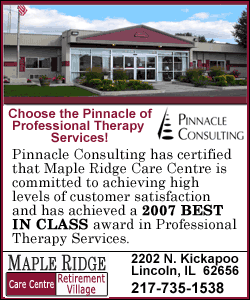 Born and raised in Lincoln, Wilmert graduated from MacMurray College
in Jacksonville in 1967. It was while at MacMurray that he met his
wife of 40 years, Leslie Brickman from Quincy. Born and raised in Lincoln, Wilmert graduated from MacMurray College
in Jacksonville in 1967. It was while at MacMurray that he met his
wife of 40 years, Leslie Brickman from Quincy.
Wilmert then went to the prestigious Northwestern University
School of Dentistry, graduating in 1971. Upon graduating, Jim and
Leslie made an important decision. "We were not yet ready to go into
private practice and settle down," he said. "We wanted to see a
little of the world first."
Wilmert thus enlisted in the U.S. Air Force and was initially
assigned to Ellsworth Air Force Base in Rapid City, S.D.
In 1973, using the benefits offered military personnel, Wilmert
entered the St. Louis University School of Orthodontics, where he
graduated with an advanced degree in 1975.

Although he liked doing general dentistry, he preferred working
with young people. "Working with young people keeps one young," he
said. "Also, it is one of the few situations in dentistry where the
patients are generally there because they want to be and not because
they have to be."
Air Force families having the same orthodontic needs as civilian
families kept Jim busy, as he served five years overseas at Ramstein
AFB in Germany between two stints at Wright Patterson AFB in Ohio.
It was in 1982 that Jim moved from active duty to a role as an
active reservist, which he maintained until his retirement from the
Air Force Reserves in 1993 as a lieutenant colonel.
It was also in 1982 that he and Leslie moved back to Lincoln,
where he set up a practice at 113 Pine in Lincoln, which is where
his orthodontics office is still located. Wilmert also has offices
in the communities of Clinton and Petersburg, both of which he has
also maintained for 25 years.
He and Leslie have raised four children: David, Darin, Melissa
and Meredith.
Reflecting back on a quarter-century in orthodontics and after
helping create more than 5,000 perfect smiles, Wilmert had these
observations to make: "In some ways orthodontics is the same as it
has been since my first days as a dentist. The biology is the same.
That doesn't change. The physics and the mechanics of orthodontics
also is the same."

Wilmert was quick to point out that many things have had marked
improvements since his early days. "The materials we use today are
much better," he said. "Today we use a product called Nitinol that
was a product derived from NASA's space program. The arch wires used
for movement are soft and pliable until warmed in the mouth, and
then they become stiffer. This product is much easier to work with
than the old stiff wires were."
Perhaps the biggest change Jim noted was the way the braces are
constructed. "In the old days, every tooth had to be banded and
brackets welded to the bands. Now, with direct-bond brackets, the
brackets are fixed to the front of the teeth, and this saves a great
deal of time, plus allows for much easier repairs and adjustments
than what we had to do years ago. In fact, when you figure in the
cost-of-living adjustment over the last 25 years, braces cost less
today then they did when I started," he said.
[to top of second column] |

Wilmert gave his due to the age of computers coming into
orthodontics. "When I started my practice, hardly anyone had ever
heard of a computer," he said. "Now, records on every patient are
right there at the touch of a key. Oral surgeons and orthodontists
can use computer models to create facial and jaw physiology to
simulate tooth movement, and have a fairly good idea of the end
result prior to any treatment."
Wilmert continued: "Another new product that is really growing in
popularity, especially with adults, is the new transparent
appliances called Invisalign. With these appliances, it isn't
apparent someone is wearing them. Many adults who didn't have their
teeth properly aligned as youngsters are opting for this method to
help them get the smile they always wanted without having a ‘metal
smile' in the process."
The times have definitely changed since Jim helped his first
patient get the smile they always wanted. "People, especially the
youngsters, are more concerned with their teeth than they were when
I was a child," he said. "When I was growing up, having braces was
almost a stigma. If you had them, you never smiled, and other kids
could be rough on someone who had ‘tinsel teeth'. Now braces are so
normal that they are almost a fashion statement."

To prove the point, Jim showed a color chart that offers over 20
different colors of ties for youngsters to choose from. Many kids
pick their school colors or those of their favorite sports teams.
Wilmert wanted to point out the great rewards his profession
offers. "With some of our patients the work is to make their smile
better. There are cases where some patient's teeth are so out of
place or shifted that the orthodontics not only completely changes
their appearance, but gives them a self-confidence they didn't have
before," he said.
Dr. Wilmert, now 62, shows no signs of slowing down as he moves
into his next quarter-century in business. He takes each smile, like
each day, one at a time.
[By MIKE FAK]
Readers can find more of Mike Fak's writing at
www.searchwarp.com
and www.problogs.com.


|